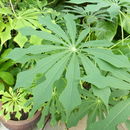Manihot esculenta, cassava, is a perennial woody shrub in the Euphorbiaceae (spurge family) native to South America but now grown in tropical and sub-tropical areas worldwide for the edible starchy roots (tubers), which are an major food source in the developing world, in equatorial regions including Africa, South America, and Oceania. Also known as yuca (although not related to the genus
Yucca), manioc, and tapioca, the dried root is the source of tapioca (used in the U.S. to make pudding). The cassava shrub may grow to 2.75 meters (9 feet) tall, with leaves deeply divided into 3–7 lobes. The shrub is often grown as an annual, and propagated from stem cuttings after tubers have been harvested. The fruit is small, roughly 1 cm (1/2 inch) in diameter, but root tubers in cultivated varieties (which require 9–18 months to grow to harvestable size) can be 5–10 cm in diameter and 15–30 cm long. Fresh roots and leaves contain cyanide compounds including linamarin (cyanogenic glucoside) and hydrocyanic acid at levels that may be toxic, but properly treated (in a labor-intensive process that may include roasting, soaking, or fermentation, as shown in this YouTube clip,
An Introduction to Cassava), the cyanide content is neglible. “Bitter” varieties contain more of these compounds than “sweet” varieties—although flavor is an imperfect indicator—but are often preferred by farmers for their pest-repellent properties. Cassava, which may be the most widely grown root crop in the world, originated in western and southern Mexico and tropical South America (likely Brazil). Archaeological evidence suggests that it was cultivated in Peru 4,000 years ago, and in Mexico by 2,000 years ago. It was introduced to West Africa in the 16th century, and became a major food crop there and in Asia. Total 2010 global production was 228 million metric tons, harvested from 18.4 million hectares, with Nigeria, Thailand, and Brazil producing the largest amounts. In optimal conditions, cassava may yield up to 68 tons per hectare in a year, but typical yields are 10 tons/hectare. In addition, cassava is often intercropped with maize, vegetables, legumes, cocoa, and coffee. Cassava tubers are prepared in various forms as a food (see
”culinary uses” in detailed entry), and are an important source of carbohydrates; they also contain significant amounts of phosphorus and iron, and are relatively rich in vitamin C. The leaves, which must also be treated to remove cyanide compounds before eating, contain 20–30% protein and are used as vegetable. Cassava is also used as a livestock feed in Latin America, the Caribbean, and Europe, and is increasingly cultivated for use as a biofuel (in China, for example). (Bailey 1976, FAOSTAT 2012, Sadik 1988, Wikipedia 2011)

